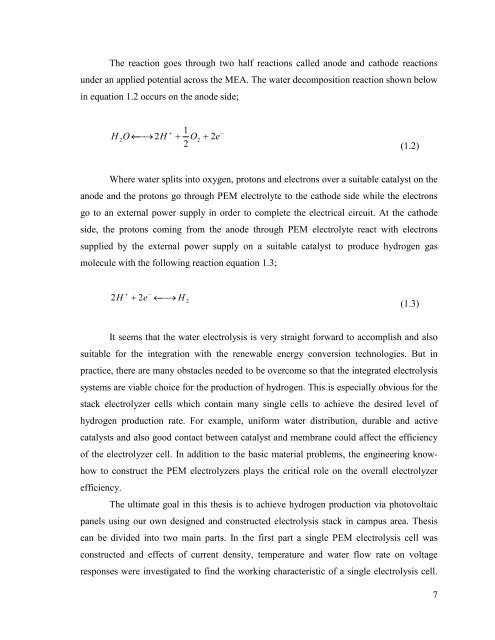hydrogen production from water using solar cells powered nafion ...
hydrogen production from water using solar cells powered nafion ...
hydrogen production from water using solar cells powered nafion ...
You also want an ePaper? Increase the reach of your titles
YUMPU automatically turns print PDFs into web optimized ePapers that Google loves.
The reaction goes through two half reactions called anode and cathode reactions<br />
under an applied potential across the MEA. The <strong>water</strong> decomposition reaction shown below<br />
in equation 1.2 occurs on the anode side;<br />
1<br />
H 2O<br />
2<br />
2<br />
+<br />
−<br />
←⎯→ 2H + O2<br />
+ e<br />
(1.2)<br />
Where <strong>water</strong> splits into oxygen, protons and electrons over a suitable catalyst on the<br />
anode and the protons go through PEM electrolyte to the cathode side while the electrons<br />
go to an external power supply in order to complete the electrical circuit. At the cathode<br />
side, the protons coming <strong>from</strong> the anode through PEM electrolyte react with electrons<br />
supplied by the external power supply on a suitable catalyst to produce <strong>hydrogen</strong> gas<br />
molecule with the following reaction equation 1.3;<br />
+ −<br />
2H + 2e<br />
←⎯→<br />
H<br />
2<br />
(1.3)<br />
It seems that the <strong>water</strong> electrolysis is very straight forward to accomplish and also<br />
suitable for the integration with the renewable energy conversion technologies. But in<br />
practice, there are many obstacles needed to be overcome so that the integrated electrolysis<br />
systems are viable choice for the <strong>production</strong> of <strong>hydrogen</strong>. This is especially obvious for the<br />
stack electrolyzer <strong>cells</strong> which contain many single <strong>cells</strong> to achieve the desired level of<br />
<strong>hydrogen</strong> <strong>production</strong> rate. For example, uniform <strong>water</strong> distribution, durable and active<br />
catalysts and also good contact between catalyst and membrane could affect the efficiency<br />
of the electrolyzer cell. In addition to the basic material problems, the engineering know-<br />
how to construct the PEM electrolyzers plays the critical role on the overall electrolyzer<br />
efficiency.<br />
The ultimate goal in this thesis is to achieve <strong>hydrogen</strong> <strong>production</strong> via photovoltaic<br />
panels <strong>using</strong> our own designed and constructed electrolysis stack in campus area. Thesis<br />
can be divided into two main parts. In the first part a single PEM electrolysis cell was<br />
constructed and effects of current density, temperature and <strong>water</strong> flow rate on voltage<br />
responses were investigated to find the working characteristic of a single electrolysis cell.<br />
7

















